1st Monmouthshire Artillery Volunteers
The 1st Monmouthshire Artillery Volunteer Corps was a unit of Britain's Volunteer Force raised in 1860 from Monmouthshire in the Welsh borders. After transfer to the Territorial Force it served with the 53rd (Welsh) Division in Palestine in World War I and in North West Europe in World War II. Its successors serve with today's Army Reserve.
| 1st Monmouthshire Artillery Volunteers 4th (Welsh) Brigade, RFA 83rd (Welsh) Field Regiment, RA 283rd (Monmouthshire) Field Regiment, RA | |
|---|---|
| Active | 4 October 1860–1 May 1961 |
| Country | |
| Branch | |
| Role | Garrison artillery Position artillery Field artillery |
| Part of | 53rd (Welsh) Division |
| Garrison/HQ | Newport, Wales |
| Engagements | Sinai and Palestine Campaign North West Europe Campaign |
Volunteer Force
The enthusiasm for the Volunteer movement following an invasion scare in 1859 saw the creation of many Volunteer Corps composed of part-time soldiers eager to supplement the Regular British Army in time of need.[1][2] An Artillery Volunteer Corps (AVC) of two batteries was formed at Newport in Monmouthshire on 4 October 1860. Two additional batteries were raised by 1863: C at Abercarn and Crumlin, Caerphilly, and D at Blackwood, Caerphilly.[3][4] Charles Lyne was appointed Major in command.[5]
In 1864 the unit was included in the 1st Administrative Brigade of Glamorganshire Artillery Volunteers, but it raised two more batteries at Newport in 1866 and became an independent unit, with Lyne promoted to Lieutenant-Colonel. In 1873 the 1st Worcestershire AVC was attached to it, and the following year the 1st Administrative Brigade of Monmouthshire Artillery Volunteers was formed, comprising the two units, with its headquarters (HQ) at Newport and Lyne in command.[3][5][6][7]
However, by 1878, the 1st Monmouths were down to a strength of two batteries, and the admin brigade was renamed the 1st Administrative Brigade of Worcestershire Artillery Volunteers, with HQ moving to Worcester. Charles Lyne retired and became Honorary Colonel of the brigade. His son, Lt-Col C.R. Lyne, became commanding officer in 1883.[3][5][7][8] When the artillery volunteers were consolidated in 1880, the brigade became the 1st Worcester (Worcester and Monmouth) AVC, with the former 1st Monmouthshire reduced to Nos 7 and 8 Batteries at Griffithstown. Recruitment picked up in Monmouthshire during the 1880s, and by the end of the decade it was large enough to be an independent corps once more, with six batteries, and the HQ returned to Newport.[3][5][7]
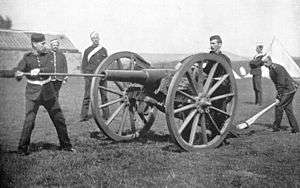
The AVCs were intended to serve as garrison artillery manning fixed defences, but a number of the early units manned semi-mobile 'position batteries' of smooth-bore field guns pulled by agricultural horses. However, the War Office (WO) refused to pay for the upkeep of field guns and the concept died out in the 1870s. It was revived in 1888 when some Volunteer batteries were reorganised as 'position artillery' with 16-pounder Rifled Muzzle-Loading guns to work alongside the Volunteer infantry brigades. The six garrison batteries of the revived 1st Monmouthshire AVC were organised into three position batteries, named heavy batteries from 1903.[3][9][10]
The 1st Worcesters had formed part of the Welsh Division of the Royal Artillery (RA) from 1882 to 1889, and the Southern Division thereafter. The 1st Monmouthshire was placed in the Western Division on being reformed. In 1899 the Artillery Volunteers were transferred to the Royal Garrison Artillery (RGA), the 1st Monmouths becoming the 1st Monmouthshire Royal Garrison Artillery (Volunteers) when the divisional organisation was abolished in 1902.[3][5][10]
Territorial Force
When the Volunteers were subsumed into the new Territorial Force under the Haldane Reforms of 1908,[11][12] the 1st Monmouthshire transferred to the Royal Field Artillery (RFA) as the IV (or 4th) Welsh Brigade, with the following organisation:[3][5][13][14]
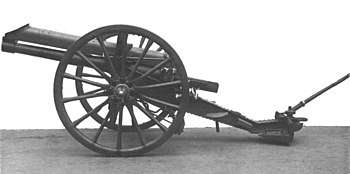
IV Welsh Brigade, Royal Field Artillery
- HQ at Drill Hall, Lime Street, Monmouth
- 1st Monmouth Battery at Newport
- 2nd Monmouth Battery at Risca[15]
- 3rd Monmouth Battery at Griffithstown[16]
- IV Welsh Brigade Ammunition Column at Newport
The Newport Cadet Corps, RFA, was also affiliated to the brigade.[5]
The new brigade unit was part of the Territorial Force's Welsh Division and the batteries were each issued with four 15-pounder guns.[17][18][19]
World War I
Mobilisation
The units of the Welsh Division had just departed for their annual summer camp when the order to mobilise was received on 4 August 1914. They then returned home and assembled at their drill halls to mobilise. The 4th Welsh Brigade mobilised at Newport under the command of Lt-Col D.E. Williams, VD, who had been CO since 1911.[5][17][20]
By 11 August the units had completed their concentration and Territorial Force members were invited to volunteer for Overseas Service. Four days later the War Office issued instructions to separate those men who had signed up for Home Service only, and form these into reserve units, and on 31 August, the formation of a reserve or 2nd Line unit was authorised for each 1st Line unit where 60 per cent or more of the men had volunteered for Overseas Service. The titles of these 2nd Line units would be the same as the original, but distinguished by a '2/' prefix. In this way duplicate batteries, brigades and divisions were created, mirroring those Territorial Force formations being sent overseas.[17][18][21]
1/IV Welsh Brigade, RFA
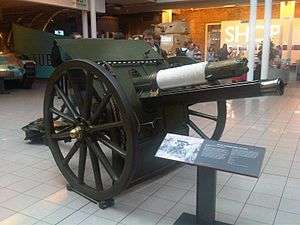
At the end of August the Welsh Division concentrated at Northampton to continue its training. On 18 November the division was warned for garrison duty in India, but this was cancelled and in December it moved to Cambridge, then to Bedford in May 1915. In July the infantry of the division (now renamed the 53rd (Welsh) Division) embarked for service at Gallipoli, but the divisional artillery remained at Bedford. In October the batteries were re-armed with modern 18-pounder guns and on 8 November they handed over their obsolescent 15-pounders to the 2nd Line unit, which had just arrived at Bedford.[17][18][20][22]
53rd (Welsh) Divisional Artillery was now ordered to France to join the British Expeditionary Force (BEF) on the Western Front. It embarked on 20 November and had concentrated at Pont-Remy by 25 November, from where parties were sent to various divisional artilleries for instruction in front line duties.[17][18][20]
Meanwhile, after suffering appalling casualties at Gallipoli, 53rd (Welsh) Division had been withdrawn to Egypt to refit. On 30 January 1916 the divisional artillery was ordered to rejoin the rest of the division. The batteries entrained at Pont-Remy, embarked at Marseilles on 3 February and disembarked at Alexandria on 11 February. By 22 February the artillery had rejoined the division at Beni Salama. For the rest of the year the recuperating division was stationed in the Suez Canal defences.[17][18]
In May 1916 the Territorial Force field brigades were numbered, the 1/IV Welsh being designated CCLXVIII (268) Bde, RFA, and the batteries became A, B and C. Then on 25 December 1916 the divisional artillery was reorganised: A Bty was broken up between B and C Btys (to make them up to six guns each) and they were redesignated A and B, while B Battery (the former 2nd Glamorgan Bty) joined from the old CCLXV (I Welsh) Bde and became C (Howitzer) Bty, equipped with 4.5-inch howitzers. The brigade itself was redesignated CCLXVI (266) Bde. 53rd (W) Divisional Ammunition Column had remained in France, and was reformed in Egypt by abolishing the Brigade Ammunition Columns.[13][17][18][20][23]
Palestine
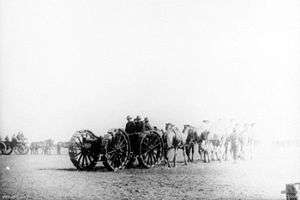
Early in 1917 the Egyptian Expeditionary Force launched the Sinai and Palestine Campaign by crossing the Sinai desert and advancing against Turkish forces at Gaza City. The First Battle of Gaza began during the night of 25/26 March when 53rd (W) Division advanced 12 miles (19 km) to cross the Wadi Ghuzzeh, with CCLXVI Bde following 158th (North Wales) Infantry Brigade. Despite the darkness and morning fog – 158th Brigade lost its way and arrived late – the infantry were in position by 08.30 and at 10.10 CCLXVI Bde opened fire on Ali Muntar. However, the attack orders were late reaching the infantry, and the main bombardment did not begin until 12.00. The division's attack went well, with 158th Bde establishing a lodgement at Ali Muntar, but the artillery was too weak to suppress the Turkish fire and casualties were heavy. By 18.30 the division had taken all its objectives and its troops were in the eastern streets of Gaza when the attack was stopped for lack of water. Although 53rd (W) Division consolidated its position, it was withdrawn the following day.[24][25]
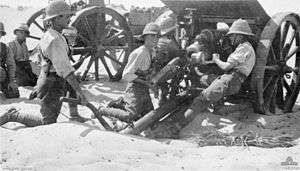
For the Second Battle of Gaza, beginning on 17 April, 53rd (W) Division's role was to advance up the coast across Wadi Ghuzzeh, and then attack Gaza after an artillery bombardment. The bombardment was begun by the heavy artillery and warships offshore, then the 4.5-inch howitzers began firing gas shells against Turkish batteries. At 07.20, 10 minutes before Zero, the 18-pounders began engaging the objectives. The infantry attacked punctually at 07.30 and 53rd (W) Division captured Samson's Ridge. However, it could not push on because the neighbouring division was badly held up. Casualties had been high and gains minimal, and the EEF dug in for a summer of trench warfare.[26][27]
Although the War Office was unable to provide more divisions for the EEF, it could send guns: 53rd (W) Division's batteries were temporarily brought up to a strength of eight rather than six guns, until further troops arrived.[28] The reorganised EEF renewed its offensive (the Third Battle of Gaza) on 27 October. XX Corps, including 53rd (W) Divisional artillery, moved into position during the night of 30/31 October to capture Beersheba, and the bombardment began at 05.55. After a pause at 07.00 to let the dust settle and determine the effect, the guns reopened. Infantry parties advanced to within 30 yards (27 m) of the barrage to finish cutting the barbed wire. They then rushed Point 1069 and the 18-pounder batteries began to move up to more advanced positions. Beersheba had fallen to the Desert Mounted Corps and XX Corps could bivouack on the objective.[29][30] On 3 November 53rd (W) Division was ordered to advance to the Tel es Sheria road. It was a difficult march over broken country in hot weather and CCLXVI Bde, escorted by 5th Battalion, Royal Welsh Fusiliers (RWF), made a wide movement out to the east where there was a track over comparatively flat ground. There were several sharp actions with enemy detachments, and 5th RWF was called from escort duty to support the attack on the Khuweilfe heights. Over following days 53rd (W) Division kept up pressure on the enemy in the hills so that the EEF could roll up the main trench lines (the Battle of Hareira and Sheria). Then on 6 November the division assaulted the Khuweilfe position supported by an intense bombardment by all its own guns and a heavy battery. After confused fighting the position was held, with the support of the divisional artillery breaking up Turkish counter-attacks.[31][32]
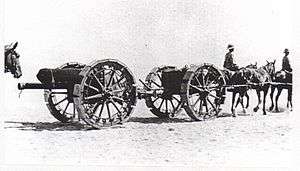
After breaking through the Gaza positions, the EEF pressed on to Jerusalem in appalling weather. The city was to be captured by XX Corps after a rapid advance by a flying column known as 'Mott's Detachment' that included 53rd (W) Division. Preliminary attacks began on 7 December and Jerusalem fell the following day, but there was still heavy fighting to the end of the year as the Turks threw in counter-attacks.[33][34]
XX Corps renewed its advance in March 1918, 53rd (W) Division pushing forward a little on 2 March, then again on 6 March against only slight opposition, before the whole Corps advanced on 8 March. 53rd (W) Division's main objective was the hill of Tell 'Asur, and it was supported by plentiful artillery as well as its own brigades. The peak was taken, lost, and retaken, followed by four more Turkish counter-attacks. That night the division also took Chipp Hill, which had defied the neighbouring division during daylight, but on 10 March found the wadi in front too steep to climb, only passing over it during darkness on 12 March. The new line was held through the summer months.[35][36]
In the summer of 1918 the 53rd Division was 'Indianised', with three quarters of the infantry battalions replaced by others drawn from the British Indian Army, but this did not affect the divisional artillery, which retained its composition to the end of the war.[17][18][37]
At the climactic Battle of Megiddo 53rd (W) Division attacked late on the first day (18 September), after an hour's bombardment. After more than 20 hours' hard fighting, the main enemy position was taken and the guns could move forward. The pressure was kept up on 20 September and by the end of the next day the Turkish army was shattered.[38]
After the battle the division was withdrawn to Alexandria before the Armistice of Mudros came into effect on 31 October. Demobilisation began on 20 December and was completed in June 1919.[17] CCLXVI Brigade was placed in suspended animation.[13]
2/IV Welsh Brigade, RFA
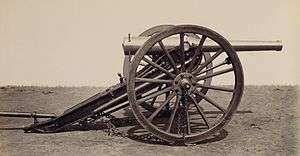
Although 2/IV Welsh Bde was raised before the end of 1914, the 2nd Welsh Division (68th (2nd Welsh) Division from August 1915) did not concentrate at Northampton until Spring 1915, the brigade joining it on 29 April. It moved to Earlswood on 4 August 1915 and then arrived at Bedford to replace the 1st Line brigade on 2 November. Training of the units was made difficult by the lack of arms and equipment, and the requirement to provide drafts to the 1st Line overseas. In June the first saddlery and horses began to arrive, but no guns until August, when the brigade received four French De Bange 90 mm guns. Some ammunition wagons arrived in September, and eight more 90 mm guns in October. Training began to speed up, with the 90 mm guns standing in for 15-pounders. When the brigade arrived at Bedford it took over 12 x 15-pounders from the 1st Line. In December 1915 these in turn were replaced by modern 18-pounders.[22][39]
68th (2nd Welsh) Division was assigned a role in Home Defence in November 1915 when it joined First Army (Home Forces) in Central Force, with its units quartered across Eastern England. In May 1916 the brigade was numbered CCCXLIII Brigade (343 Bde) and the batteries became A, B and C. Later in the year CCCXL (Howitzer) Bde (formerly 2/I Welsh Bde) was broken up and its A Bty (formerly 2/1st Glamorgan Bty) joined CCCXLIII Bde as D (H) Bty.[13][22]
The Home Defence divisions continually supplied drafts to units fighting overseas. In the autumn of 1916, A/CCCXLIII Bty was detached tand replaced by a newly-raised 502 (H) Bty, RFA. A Battery was then given back its old Territorial Force title as 502 (2/1 Monmouth) (Howitzer) Battery and left for France, while the new battery in CCCXLIII Bde was renumbered as 545 (H) Bty. 502 (2/1 Monmouth) (H) Bty disembarked at Le Havre on 6 October 1916, left two days later and joined CXXVI Bde RFA in 37th Division on 9 October, becoming its C (H) Bty on 23 October. It was equipped with four 4.5-inch howitzers.[40][41]
37th Division had been in France since the middle of 1915, but it had still not taken part in a major operation. Now it was involved in the Battle of the Ancre (the last phase of the Somme Offensive) starting on 13 November. 37th Divisional Artillery was in the line for the whole six-day battle, at first covering the front of 63rd (Royal Naval) Division before 37th Division took over the front.[41]
On 25 January 1917, C(H)/CXXVI Bty (the former 2/1 Monmouth Bty) was broken up and its Right and Left Sections used to make up D(H)CXXIII and D(H)CXXIV Btys up to six howitzers each. These two batteries served with 37th Divisional Artillery on the Western Front for the rest of the war.[41]
The rest of CCCXLIII Bde had disappeared from 68th (2nd W) Division's order of battle by mid-1917.[22]
Interwar
The brigade was reformed in the 53rd (W) Division in 1920, initially as 3rd Welsh Brigade, RFA, and redesignated the 83rd (Welsh) Brigade, RFA, when the Territorial Force was reorganised as the Territorial Army (TA) in 1921 (becoming a Field Brigade, RA, in 1924 when the RFA was subsumed into the Royal Artillery). The howitzer battery was formed from a squadron of the Montgomeryshire Yeomanry and a company of the 1st Battalion, Herefordshire Regiment, giving the brigade the following organisation:[5][13][42]
- HQ at Drill Hall, Mendalgief Road, Newport, later at Lime Street, then at Dock Street
- 329 (Monmouthshire) Field Bty at Newport
- 330 (Monmouthshire) Field Bty at Cross Keys
- 331 (Monmouthshire) Field Bty at Griffithstown
- 332 (Radnorshire) Field Bty (Howitzers) at Llandrindod Wells, Radnorshire, later at Knighton
The brigade was once more in 53rd (W) Division.[42] Field Brigades were termed Field Regiments from 1938 onwards.[13]
World War II
Mobilisation
The TA was doubled in size following the Munich Crisis of 1938, with existing units splitting to form duplicates before the outbreak of World War II. 83rd Field Regiment reorganised as follows:[13][43]
83rd (Welsh) Field Regiment
- 329 (Monmouthshire) Field Bty at Newport
- 330 (Monmouthshire) Field Bty at Cross Keys
133rd (Welsh) Field Regiment
- 331 (Monmouthshire) Field Bty at Griffithstown
- 332 (Radnorshire) Field Bty at Knighton
Both regiments were in 53rd (Welsh) Division throughout World War II and shared similar histories.[44]
Home defence
Parts of 53rd (Welsh) Division were sent to Northern Ireland from October 1939, and the whole division was stationed there from 3 April 1940 to 30 April 1941 as part of VI Corps.[44][45][46][47] The establishment of a field regiment from 1941 onwards was three batteries, each of two four-gun troops of 25-pounders with Quad gun tractors.[48]
On returning to mainland Britain, the division served under III Corps and Western Command. On 8 April 1942 it was assigned to XII Corps District, then from 15 May 1943 in XII Corps it became part of 21st Army Group training for the Allied invasion of Normandy (Operation Overlord).[44][49]
Normandy
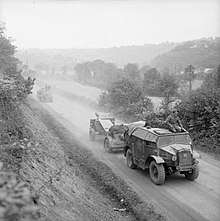
53rd (Welsh) Division was among the follow-up troops landing after D-Day (6 June). Its units were at sea from 21 June and completed landing on 27 June.[44] On 1 July it relieved 15th (Scottish) Division on the River Odon after the Battle of 'Scottish Corridor'.[50] 53rd Division was then involved in the Second Battle of the Odon from 15 July, capturing Cahier and holding on to it by hard fighting.[51][52] When the breakout from the Normandy beachhead began in early August, 53rd Division cleared the banks of the River Orne and then fought its way towards Falaise to help in closing the Falaise Pocket. By late August its units were across the Seine and driving over open country towards the River Somme.[53][54][55] On 4 September the division cleared St Pol and was working its way through the canal area west of Lille.[56][57] On 12 September 83rd Regiment moved into the outskirts of Antwerp, where they were treated with hospitality by the liberated inhabitants, even while engaging enemy targets round the docks in grain elevators, tall buildings and hotels.[58]
Netherlands
There was a pause at the Meuse-Escaut Canal before Operation Market Garden was launched on 17 September. XII Corps had an important subsidiary role clearing the country west of XXX Corps' main thrust.[59][60] 83rd Field Regiment came into action to support 158 Bde's crossing of the Meuse-Escaut Canal, suffering some casualties from Luftwaffe air attack on the night of 18–19 September while crossing the canal. 133rd came into action and crossed the canal the following day in support of 160th Bde.[58][61]
On 4 October, the 83rd Regiment moved to Sint-Oedenrode in the Market Garden 'corridor' supporting 158th Brigade, and two days later 133rd Regiment moved with 160th Bde into the Nijmegen bridgehead captured during Market Garden. Both positions were under frequent fire: on 13 October the 330 Battery of the 83rd Regiment was shelled as the Germans prepared a counter-attack against 158th Bde; the battery lost seven killed and 12 wounded when the battery command post (CP) was hit by two shells. The CP was quickly re-established and the battery's defensive fire tasks were instrumental in defeating an attack that got within 20 yards (18 m) of 158th Bde's positions.[58][61][62] On 16 October 83rd Regiment took part in Operation Winkle: an intense fire programme by all arms rising to a crescendo, followed by loudspeaker appeals to German soldiers to desert to the Allied lines, covered by a smokescreen fired by the regiment.
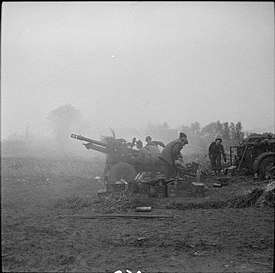
After the failure of Market Garden, XII Corps was ordered to advance westwards towards 's-Hertogenbosch. The regiments left the Nijmegen area on 19 October and took up new gun positions. The attack on s'Hertogenbosch (Operation Alan) began at 06.30 on 22 October, the infantry of 160th Bde advancing behind a timed artillery programme, after which the guns moved forward. After two days' fighting, 158th Bde took up the attack, but it took two more days of house-to-house fighting supported by the artillery to clear the old town.[58][61][63][64][65]
Next XII Corps was switched to clearing the country between the Wessem and Zig Canals as 21st Army Group closed up to the River Maas.[66] On 14 November the corps carried out Operation Mallard o cross the Wessem Canal. Both regiments fired in support of 51st (Highland) Division's assault crossing (Operation Ascot), followed by 53rd (W) Division's own crossing (Operation Bristol) in the evening.[58][61][67]
On 3 December the guns supported 15th (S) Division in Operation Guildford to clear the banks of the Maas up to Blerick, opposite Venlo. The Commanding Officer of the 133rd Field Regiment was responsible for firing a large-scale smokescreen, which was maintained for over 11 hours during the operation, which was described as 'textbook'.[61][68][69] Further operations were halted by winter weather. On 20 January 1945 the division moved to the Eindhoven area to refit and train for a special operation. On the night of 4/5 February the gunners moved into concealed positions near Nijmegen.[61]
Operation Veritable
The Battle of the Reichswald (Operation Veritable) opened at 05.00 on 8 February with the heaviest concentration of artillery employed by the British Army so far in the war. The bombardment hit enemy gun positions, HQs, and communications. After a pause and dummy attack at 07.40 to induce the Germans to man their guns, the Counter-battery fire was resumed and a barrage was laid down to protect the assaulting columns. At 10.30 the full barrage made its first lift and the advance began. Both regiments supported the advance of 71st Bde. By 15.00, 133rd Regiment was out of range, but it took over 2 hours to extract its guns from their muddy positions to move forward. 83rd Regiment also moved forward at 19.00. 53rd Division's objectives were the Brandenburg and Stoppelberg features in the northern part of the Reichswald. Opposition was not strong but the terrain was difficult. By 02.00 on 9 February the leading units were through the Siegfried Line defences and closing on the Stoppelberg. That feature was taken during the morning and the division pushed on to the edge of the forest, but it was hard to get guns and vehicles along the muddy forest tracks. The regiments deployed on German soil for the first time on 11 February. It took several days for the division to push on through Pfalzdorf towards Goch, mopping up opposition and fending off counter-attacks. Goch fell on 21 February.[58][61][70]
53rd Division was not involved in the assault crossing of the Rhine (Operation Plunder) on 23/24 March, but it crossed on 26 March and the next day attacked through Hamminkeln to Dingden. It then took part in the drive to the Elbe.[71] The German surrender at Lüneburg Heath, ending the fighting on 21st Army Group's front, came on 4 May.
83rd and 133rd (Welsh) Field Regiments were placed in suspended animation in 1946; 133rd was subsequently disbanded in 1947.[13][72]
Postwar
When the TA was reconstituted in 1947, the 83rd Field Regiment was reformed at Newport as 283rd (Welsh) Field Regiment in 53rd (Welsh) Division. In 1953 the title was changed to 283rd (Monmouthshire) Field Regiment.[13][73][74]
On 10 March 1955 the regiment absorbed 603rd (1st Rifle Bn, The Monmouthshire Regiment) (Mixed) Heavy Anti-Aircraft Regiment at Newport, with the latter contributing P (1 Monmouthshire) Bty to the merger. On 1 May 1961 the regiment merged again, this time with two of the original field regiments of 53rd (W) Division, 281st (Glamorgan Yeomanry) Field Regiment and 282nd (Welsh) Heavy AA Regiment to form 282nd (Glamorgan and Monmouthshire) Field Regiment, with the following organisation:[13][73][75][76]
- P (Glamorgan Yeomanry) Bty – from 281st Field Regiment
- Q (Welsh) Bty – from 282nd HAA Regiment
- R (1 Monmouth) Bty – from 283rd Field Regiment
- 509 (Motor Transport) Company, Royal Army Service Corps – from surplus personnel of 281st Field Regiment, 282nd HAA Regiment Workshop, Royal Electrical and Mechanical Engineers, and 533 Co Royal Army Service Corps
Finally, when the TA was reduced into the Territorial and Army Volunteer Reserve in 1967, the combined regiment became 211 (South Wales) Battery, Royal Artillery at Newport in 104 Light Air Defence Regiment, RA, with the following organisation:[13][73][76][77]
- D (Monmouthshire) Troop at Newport
- E (Glamorgan Yeomanry) Troop at Cardiff
- F (Brecknockshire and Monmouthshire) Troop at Ebbw Vale
In 1986, 211 Bty provided a cadre for a new 217 (County of Gwent) Bty at Cwmbran, but this was absorbed by HQ Bty in 1992, when 211 Bty was reduced to:[76][77]
- C (Glamorgan Yeomanry) Troop at Cardiff
- D (Brecknockshire and Monmouthshire) Troop at Abertillery.
211 (South Wales) Bty continues in 104th Regiment Royal Artillery (Volunteers) in the Army Reserve today, currently as a close support unit equipped with the L118 light gun.[78]
Honorary Colonels
The following served as Honorary Colonel of the unit:[5]
- Charles Lyne, former CO, appointed (to 1st Worcester Admin Bde, and remained with Worcesters thereafter) 9 November 1878, died 1901.[8]
- John Rolls, 1st Baron Llangattock, appointed (to 1st Monmouth) 4 October 1890
- C.T. Wallis, VD, former CO, appointed 13 June 1914
- Col W.C. Phillips, VD, appointed 31 March 1922
- Lt-Col T.W. Pearson, DSO, TD, appointed 19 September 1936
Memorial
There is a brass plate bearing the names of 28 members of 83rd Field Regiment killed in the NW Europe campaign in St Peter's and St Paul's Church, East Sutton, near Maidstone in Kent.[79][80]
Notes
- Beckett.
- Spiers, pp. 163–8.
- Litchfield & Westlake, pp. 131–2.
- Beckett, Appendix VIII.
- Army List, various dates.
- Litchfield & Westlake, p. 81.
- Litchfield & Westlake, p.172.
- Lyne Obituary, Evening Express, 8 July 1901 at Welsh Newspapers Online.
- Beckett, pp. 178–9.
- Litchfield and Westlake, pp. 3–6.
- Dunlop, Chapter 14.
- Spiers, Chapter 10.
- Litchfield, pp. 181–2.
- London Gazette 20 March 1908.
- Risca at Drill Hall Project.
- Griffithstown at Drill Hall Project.
- Becke, Pt 2a, pp. 117–23.
- 53 (W) Division at Long, Long Trail.
- Conrad, British Army, 1914.
- "53 (W) Division at Regimental Warpath". Archived from the original on 2009-11-14. Retrieved 2009-11-14.
- Becke, Pt 2b, p. 6.
- Becke, Pt 2b, pp. 83–90.
- Ward, p. 66.
- Farndale, Forgotten Fronts, pp. 81–4.
- MacMunn & Falls, Vol I, pp. 286–97, 301–3, 310–5.
- Farndale, Forgotten Fronts, pp. 87–9.
- MacMunn & Falls, Vol I, pp. 335–7, 343, 348.
- Farndale, Forgotten Fronts, pp. 90–1, 93.
- Falls, Vol II, pp. 44–7.
- Farndale, Forgotten Fronts, pp. 98–9.
- Falls, Vol II, pp. 84–7, 94.
- Farndale, Forgotten Fronts, pp. 104–5.
- Farndale, Forgotten Fronts, pp. 113–6.
- Falls, Vol II, pp. 238–44. 250–1, 281–2.
- Farndale, Forgotten Fronts, pp. 113.
- Falls, Vol II, pp. 312–21.
- Farndale, Forgotten Fronts, p. 124.
- Farndale, Forgotten Fronts, pp. 129–34.
- RFA at When the Welsh Came to Bedford.
- Army Council Instruction 2063 of 1 November 1916.
- Becke, Pt 3b, pp. 71–9.
- Titles and Designations, 1927.
- Western Command 3 September 1939 at Patriot Files.
- Joslen, pp. 87–8.
- Joslen, pp. 346, 348.
- Farndale, Years of Defeat, Annex D.
- Collier Maps 17 and 20.
- Farndale, p. 99.
- Order of Battle of the Forces in the United Kingdom, Part 2: 21 Army Group, 24 July 1943, with amendments, The National Archives (TNA), Kew, file WO 212/238.
- Martin, pp. 51–5.
- Ellis, Vol I, p. 334.
- Martin, pp. 73–6.
- Ellis, Vol I, pp. 408, 440, 470.
- Buckley, pp. 188–9.
- Martin, pp. 108–9, 118–9.
- Ellis, Vol II, p. 6.
- Martin, pp. 120, 127, 143.
- 83 Fd Rgt at RA Netherlands.
- Ellis, Vol II, p. 44.
- Martin, pp. 145–6, 149–50.
- 133 Fd Rgt at RA Netherlands.
- 83 Fd Rgt Roll of Honour at RA Netherlands.
- Ellis, Vol II, pp. 123–4.
- Buckley, pp. 244–5.
- Martin, pp. 173–4.
- Ellis, Vol II, p. 160.
- Buckley, pp. 239–40.
- Buckley, pp. 240–1.
- Martin, pp. 214–9.
- Ellis, Vol II, pp. 257–67.
- Ellis, Vol II, pp. 293, 305–6, 310.
- Farndale, Years of Defeat, Annex M.
- 266–288 Regiments RA at British Army 1945 on.
- Watson, TA 1947.
- Litchfield, p. 78.
- "South Wales Artillery at Regiments.org". Archived from the original on 2005-12-27. Retrieved 2005-12-27.
- Litchfield, p. 183.
- 104 Regiment history at MoD website.
- IWM War Memorial Register Ref 16279.
- Illustrated at RA Netherlands.
References
- Maj A.F. Becke,History of the Great War: Order of Battle of Divisions, Part 2a: The Territorial Force Mounted Divisions and the 1st-Line Territorial Force Divisions (42–56), London: HM Stationery Office, 1935/Uckfield: Naval & Military Press, 2007, ISBN 1-847347-39-8.
- Maj A.F. Becke,History of the Great War: Order of Battle of Divisions, Part 2b: The 2nd-Line Territorial Force Divisions (57th–69th), with the Home-Service Divisions (71st–73rd) and 74th and 75th Divisions, London: HM Stationery Office, 1937/Uckfield: Naval & Military Press, 2007, ISBN 1-847347-39-8.
- Maj A.F. Becke,History of the Great War: Order of Battle of Divisions, Part 3b: New Army Divisions (30–41) and 63rd (R.N.) Division, London: HM Stationery Office, 1939/Uckfield: Naval & Military Press, 2007, ISBN 1-847347-41-X.
- Ian F.W. Beckett, Riflemen Form: A Study of the Rifle Volunteer Movement 1859–1908, Aldershot: Ogilby Trusts, 1982, ISBN 0 85936 271 X.
- John Buckley, Monty's Men: The British Army and the Liberation of Europe, London: Yale University Press, 2013, ISBN 978-0-300-13449-0.
- Col John K. Dunlop, The Development of the British Army 1899–1914, London: Methuen, 1938.
- Major L.F. Ellis, History of the Second World War, United Kingdom Military Series: Victory in the West, Vol II: The Defeat of Germany, London: HM Stationery Office, 1968/Uckfield: Naval & Military, 2004, ISBN 1-845740-59-9.
- Gen Sir Martin Farndale, History of the Royal Regiment of Artillery: The Forgotten Fronts and the Home Base 1914–18, Woolwich: Royal Artillery Institution, 1988, ISBN 1-870114-05-1.
- Gen Sir Martin Farndale, History of the Royal Regiment of Artillery: The Years of Defeat: Europe and North Africa, 1939–1941, Woolwich: Royal Artillery Institution, 1988/London: Brasseys, 1996, ISBN 1-85753-080-2.
- Norman E.H. Litchfield, The Territorial Artillery 1908–1988 (Their Lineage, Uniforms and Badges), Nottingham: Sherwood Press, 1992, ISBN 0-9508205-2-0.
- Norman Litchfield & Ray Westlake, The Volunteer Artillery 1859–1908 (Their Lineage, Uniforms and Badges), Nottingham: Sherwood Press, 1982, ISBN 0-9508205-0-4.
- Lt-Gen H.G. Martin, The History of the Fifteenth Scottish Division 1939–1945, Edinburgh: Blackwood, 1948/Uckfield: Naval & Military Press, 2014, ISBN 978-1-78331-085-2.
- Edward M. Spiers, The Army and Society 1815–1914, London: Longmans, 1980, ISBN 0-582-48565-7.
- Titles and Designations of Formations and Units of the Territorial Army, London: War Office, 7 November 1927 (RA sections also summarised in Litchfield, Appendix IV).
- War Office, Army Council Instructions Issued During November 1916, London: HM Stationery Office, 1916.
External sources
- Mark Conrad, The British Army, 1914 (archive site)
- British Army units from 1945 on
- The Drill Hall Project
- Imperial War Museum, War Memorials Register
- The Long, Long Trail
- The Regimental Warpath 1914–1918 (archive site)
- Land Forces of Britain, the Empire and Commonwealth – Regiments.org (archive site)
- Graham Watson, The Territorial Army 1947